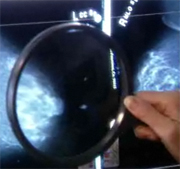
TUESDAY, June 28 (HealthDay News) — Mammography screening reduces breast cancer deaths even more than most experts have long believed, according to a new, large-scale Swedish trial.
In a study with a follow-up of nearly three decades — the longest ever — the researchers found that the benefits of the screenings become clearer as the decades roll on.
In fact, most of the benefits occur more than 10 years after mammography begins, and the screenings prevent far more breast cancer deaths than other, shorter studies have found, the report indicated.
“The big news is that if one considers the long-term effects on breast cancer mortality, the absolute benefit of screening in terms of number of lives saved is considerably greater than previously thought,” said lead author Stephen W. Duffy, professor of cancer screening at Queen Mary, University of London.
Experts have long debated the best age for mammography screening to begin and how often it should be done.
In the new study, Duffy and colleagues looked at more than 133,000 women ages 40 to 74, living in two Swedish counties.
Researchers assigned them either to a group invited to mammogram screening or a group receiving usual care. The screening phase lasted about seven years. Women aged 40 to 49 got invited to screening every two years; women 50 to 74 every 33 months. The follow-up lasted 29 years.
For every 1,000 to 1,500 mammograms, one breast cancer death was prevented, Duffy’s team found.
Other analyses have found, for instance, that for every 2,500 women aged 40 to 49 invited to screening, one death was prevented.
The study, whose authors reported no conflicts of interest, is published in the June 28 online edition of the journal Radiology.
“I was surprised and reassured by how long-lasting the effect was, and how consistent over three decades,” Duffy said.
Most of the benefit occurs more than 10 years after the screening starts, he added.
It was not possible to “tease out” the specific benefit of screening women in their 40s, one area of debate, he noted. But other reviews suggest that “although the benefit is smaller, there is still a mortality reduction with screening women in their 40s,” Duffy said.
At the end of the study, the investigators found 30 percent fewer breast cancer deaths overall in the group invited to screening compared to those not screened.
There was also a substantial absolute reduction in cancer deaths. At 29 years of follow-up, 34 to 42 years of life were saved for each 1,000 women screened for seven years, and one breast cancer death prevented for every 414 to 519 women. Had the screening continued another 10 years with the same benefits, only 300 screenings would be needed to save one life, the study reported.
In addition, for every 1,000 women screened every two years from ages 40 to 69, about eight to 11 deaths from breast cancer would be prevented, according to the study authors.
Duffy said he does not expect the study results to put to rest the mammography debate.
“There will always be skeptics, who argue that the benefits of screening are too small to justify its financial and human costs,” Duffy said. “They have tended to argue this on the basis of deaths prevented during 10 years of screening. Our results show that this argument is invalid, since the majority of the mortality benefit occurs more than 10 years after starting screening.”
He and his colleagues noted that the drawbacks of mammography include the risk of radiation exposure and over-diagnosis. However, they wrote that the radiation dose in this trial was much smaller than most modern procedures since it was single-view mammography and over-diagnosis occurred in only a “small fraction” of the cases.
The findings are similar to those from previous studies, said Dr. Virginia Moyer, head of the U.S. Preventive Services Task Force, which in 2009 advised that the decision to start regular screenings every two years before age 50 should be discussed with a woman’s doctor. It recommends screening every other year for women aged 50 to 74.
The findings, she said, will not significantly impact the debate.
Moyer added: “When the task force reviewed all evidence for women 40 to 49, it found that about 2,000 to 2,500 women had to be invited to mammography screening to prevent one breast cancer death, which would be 40 to 50 per 100,000 women.”
Another expert, Dr. Stephanie Bernik, chief of surgical oncology at Lenox Hill Hospital in New York City, said the study “proves what most clinicians hold to be true: screening mammograms save lives.”
More information
To learn more about the screening guidelines, visit the U.S. Preventive Services Task Force.

